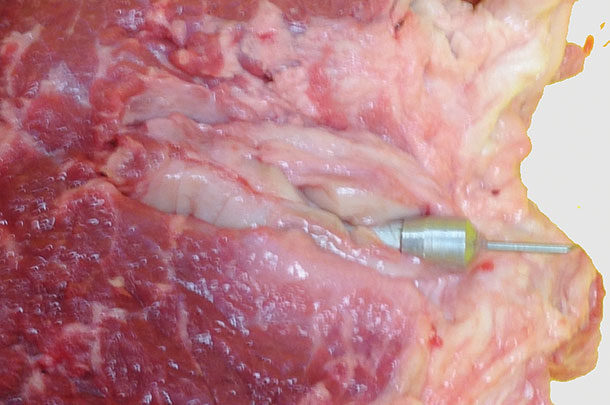The concept of using darts to give a full therapeutic dosage of antibiotics at long range has taken life in the cow-calf segment. Some ranchers are eagerly adopting such technologies, while others are more hesitant. Different facets of the industry question the long-term viability and success of such treatment methods.
The differing opinions bring to mind some of the big questions: Are these just a passing fad and an excuse for cowboys to bring more man toys to work? Or are they a serious solution to the mounting challenges that come with raising range cattle in the modern era?
The beginning of an innovation
Jason Douglas, who has worked directly in the livestock pharmaceutical industry for over 20 years and is himself a stocker-backgrounder operator, has been following the growth and adoption of these systems since their beginnings in his home state of Oklahoma. Firsthand, he witnessed the impact of the release of low-volume, long-acting antibiotics to treat respiratory disease.
“It really opened up the door for opportunities for new treatment methods,” he says. “Before remote injector systems, our only real option for treating those cattle was roping and doctoring them. But as people got older, or people with that skill set got harder and harder to find, it got difficult to treat those animals when they get sick in that environment.”
With the introduction of low-volume antibiotics, ranchers sought new methods to deliver them. One such concept was using a dart gun as utilized with wild game or animal control industries. As more ranchers started using the idea, treatment success rates noticeably went up. Chasing, roping, moving and doctoring all cause unnecessary stress; remote injection conveniently does not.
Primarily via word of mouth, this idea moved beyond western Oklahoma and became more practiced in the larger cattle world. Douglas stresses the growth of these methods is the direct result of ranchers’ ingenuity. It wasn’t until after they had been using them on cattle that manufacturers took interest in this as a viable market.
Raising concerns
Within the past three or four years especially, RDDS have really taken off and gained traction and generated plenty of discussion in different cattle circles. They began to receive some critical feedback as packers raised concerns when they were finding remnants of entire projectiles embedded in animals on the kill floors, in fabrication, by customers, some foreign, and in wholesale meat cuts.
“A packer customer found a dart lodged in a beef hind leg muscle cut, followed by one of the big three packers indicating their heightened surveillance following the incidence was yielding,” says Dr. Dee Griffin, DVM, of West Texas A&M University. “That was one dart completely embedded in a carcass each month.”
He highlights a number of the points that went along with this, being both serious and not serious issues. These included injection site damage, pharmacodynamic (i.e., the amount of active drug and its delivery to the intended body compartments is altered or “how the drug behaves within the animal’s body after delivery”) and not having darts sized to accommodate selected medication.
Another serious issue, he notes, is that from a food safety standpoint, an embedded medical dart found in a carcass qualifies as being an “adulterant,” violating both U.S. and international safety laws.
“Over three decades ago, I used darts on rare occasions to treat stocker cattle,” says Griffin. “But I was never satisfied the darts properly delivered the medications, based on examining injection sites on cattle that died following a treatment failure.”
Beef Quality Assurance (BQA) tries to be at the forefront of these concerns and issues. There has been expressed interest and concern raised to advocate for a universal “best practice” and BQA-certifiable methodology to implement for the use of these devices. This way there could be some form of industry-wide training and mutual understanding.
Of the different RDDS on the market, Griffin believes Pneu-Dart is by far the most BQA-compliant. “Pneu-Dart has two darts (one-half-inch and three-fourths-inch tri-port) that fit BQA needs,” he says. “I worry the FDA will declare the ‘retention collar’ used on their dart an adulterant and forbid selling cattle which have received medications from the Pneu-Dart system.
Pneu-Dart has developed over 20 online training lessons that include testing … If you strictly followed their use guidelines as taught in their training, problems with dart delivery seem to be minimal. I have repeatedly cultured over 20 darts and have never found one contaminated with bacteria from the manufacturer.”
Griffin further explains, “Other dart manufacturers provide extremely poor use training; their darts have not been free of contamination, and those designed for reuse are extremely difficult to sanitize in such a way as to not decrease the efficacy of the drug following sanitization.”

In response to these concerns, multiple studies were conducted. Research conducted at Iowa State University found in four of 15 calves, remote drug delivery of tulathromycin was unsuccessful. This study also found using 1.9-centimeter, 14-gauge needles to deliver the same dosage caused increased acute stress and muscle damage when delivery was done with RDD technologies compared to handheld.
It is important to note the American Association of Bovine Practitioners (AABP) stresses the dangers of improper, inadequate dosages of antimicrobials, which can lead to bacterial resistance and a poor treatment response.
Texas A&M University looked at the impact of beef quality with RDDS. The mixed results concluded darts may result in some changes in beef tenderness and somewhat alter plasma pharmacokinetics.
Douglas was asked to work with veterinarian Dr. David Bechtol to conduct such research. The resulting study found with proper equipment, including correct needle size and controlled projectile velocity, the dosage and administration was indeed successful and without damage to the carcass.
The study, which delivered 68 RDDS, concluded a half-inch, 14-gauge needle is sufficient to deliver subcutaneous injections equal to the accuracy of a traditional hand syringe injection. They found one big factor to the safety of such devices is the speed at which projectiles are launched. For example, dart guns that can’t have the velocity manually adjusted should never be used.
“In every instance we’ve been able to find where a projectile was embedded into an animal or there has been damage done traces back to the use of the wrong tool,” explains Douglas.
Likewise, using needles over one-half inch are unnecessary and are likely to cause muscle damage or embedded projectiles.
Douglas notes treatment with darts is something ranchers should be discussing and working on with their veterinarians and other animal health professionals. One of the issues is: There is still a lack of education and understanding among these facets of the industry as well. “If we can train the trainers on the correct use … that’s going to be a far more effective means, so they currently are working with not only veterinarians but also animal health professionals.”
Where will we go from here?
As with any new technology gaining traction, RDDS clearly have their bumps and learning curves along the road to full adoption. However, with the help of science and some industry collaboration, these issues may be smoothed out. The devices could have a place in the future of ranching if different industry sectors work together to address the concerns and potential misuse of these technologies.
Griffin gives a word of caution, “RDDS research documents increased stress in cattle receiving the medication via dart compared to a traditional needle and syringe as well as decreased medication uptake and therefore efficacy. RDDS use at the very least should be carefully considered. Picking an inappropriate dart or propulsion charge will lead to poor treatment response or carcass damage, damage regularly documented by packers and their customers.”
“Just step back from the fact that there’s a gun and a dart involved, and conceptualize what’s going on,” says Douglas. “The reason it has gained so much popularity lately is: It has made a very difficult job prior to its existence, capturing an animal in open country, treating him by hand, is the primary reason it’s gaining in popularity. In what other aspect in our day-to-day lives have we had something come along that made a tough job easier, and then we go back to doing it the more difficult way?” ![]()
PHOTO 1: This image shows a remote drug delivery device dart recovered in the carcass during fabrication tests done at West Texas A&M University.
PHOTO 2: In this photo, Dr. Dee Griffin, right, conducts training with a student to properly use remote drug delivery systems. The medication delivery is done on recently euthanized cattle, as shown in background. Photos courtesy of Dee Griffin, West Texas A&M University.
Jaclyn Krymowski is a freelance writer based in Ohio.












